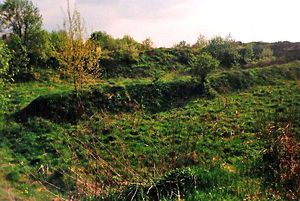Battle of Tannenberg facts for kids
Quick facts for kids Battle of Tannenberg |
|||||||
|---|---|---|---|---|---|---|---|
| Part of the East Prussian campaign of the Eastern Front in World War I |
|||||||
|
Russian prisoners of war after the battle |
|||||||
|
|||||||
| Belligerents | |||||||
| Commanders and leaders | |||||||
| Units involved | |||||||
| Strength | |||||||
| 150,000 294 machine guns 728 guns and howitzers |
230,000 384 machine guns 612 guns and howitzers |
||||||
| Casualties and losses | |||||||
| 21–30 August: 13,873+: 1,726+ KIA 7,461 WIA 4,686 MIA |
122,000–170,000: 30,000–78,000 killed or wounded 92,000 POW 350–500 guns captured |
||||||
The Battle of Tannenberg was a very important fight between the Russian Empire and the German Empire. It happened at the start of World War I in August 1914. This battle involved the Russian First and Second Armies and the German Eighth Army. It ended with a huge loss for the Russian Second Army.
The battle took place near a town called Allenstein. The Germans named it after Tannenberg. They did this to remember an old defeat at the medieval Battle of Grunwald. In that battle, the Germans (Teutonic Knights) lost to the Lithuanians. By naming this new victory Tannenberg, they felt they had made up for that old loss.
Contents
How the Battle of Tannenberg Began
Before the battle, the Russian army was moving into Germany. They used radios to send their attack plans. But they made a big mistake: they didn't scramble their messages. They thought the Germans wouldn't have people who could understand Russian.
However, the Germans easily listened in on these radio talks. This meant they knew almost every move the Russians planned to make. The Russian armies were heading into East Prussia, aiming for a city called Königsberg.
The Battle Unfolds
At first, things seemed to go well for the Russians. They pushed forward, but the Germans fought back on August 20. The German commander, General Maximilian von Prittwitz, was removed from his job. This happened because he wanted to give up East Prussia to the Russians completely. The German leaders were worried because their main plan, the Schlieffen Plan, wasn't working well on the Western Front.
While new soldiers were on their way, a smart German officer named Max Hoffmann changed how the German forces were set up. Hoffmann's plan was clever. He left a small group of soldiers to slow down the Russian 1st Army. This army was coming from the east. At the same time, he set a trap for the Russian 2nd Army. This army, led by General Alexander Samsonov, was moving up from the south.
The German field commander, General Hermann von Francois, let the Russian 2nd Army advance. Then, he cut them off from their supplies. This trapped many Russian soldiers. The Russian 2nd Army was almost completely destroyed near Frogenau. About 30,000 Russian soldiers were killed, and 90,000 were captured.
What Happened After the Battle
General Samsonov, the leader of the Russian 2nd Army, was very upset about the huge loss. He took his own life on August 29, 1914. His body was found by a German patrol the next day.
The German victory was a big deal. It forced the other Russian army, led by General Rennenkampf, to leave East Prussia. This cleared German land of the invading Russian forces.
Interesting Facts About the Battle of Tannenberg

- The Germans could understand the Russian radio messages because they were not coded. The Russians, however, could not understand the German messages.
- The battle lasted for four days, from August 26 to August 30, 1914.
- At the end of the battle, the Russians had about 30,000 soldiers killed or wounded. Another 90,000 were taken prisoner.
- This battle was Russia's worst defeat during WW I.
- The battle was named Battle of Tannenberg because Hindenburg specifically asked for it. He chose this name because of its history. It was the place where the Teutonic Knights were defeated by Slavic forces in the Battle of Grunwald.
- A large memorial, the Tannenberg Memorial, was built in 1924. It was near a town now called Olsztynek. Polish authorities later tore it down in 1949.
Images for kids
-
Vivat ribbon remembering the Battle of Tannenberg. It shows Wilhelm II and "Hindenburg the victor of Tannenberg."
See also
 In Spanish: Batalla de Tannenberg (1914) para niños
In Spanish: Batalla de Tannenberg (1914) para niños









